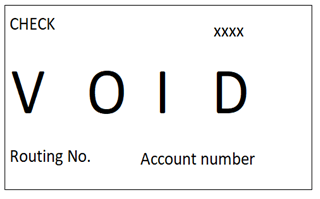
Definition of Voided Check
A voided check has the word ‘void’ written across the check which is used to make it easier for providing banking information to someone and can be used for recordkeeping purposes.
A voided check contains the word ‘VOID’ across the front end of the check. The word void indicates that the check cannot be accepted for the payment purpose. But the check can be used to get the banking information. By voiding the check, it can be prevented to use as a blank check. In other words, if a thief gets hold of the voided check then also it cannot be misused by entering payee information and entering large values. For this, the word void should be written big and dark enough across the check.
Purpose of A Voided Check
A voided check can be used for various purposes such as below:
- A voided check can be used to provide some banking information to another person or the organization. It cannot be misused since voided check cannot be used as transferring the amounts.
- If for a business, direct payment or electronic payment is necessary then a voided check can be used to process the auto payment setup.
- Let’s assume you are working for an organization. You want to get direct deposits from the organization which is faster electronically way. But for that, you may need to provide banking information to the organization such as bank account number. By voiding a check, you can provide the information to the organization.
Example of A Voided Check
A voided check is a normal check except the word ‘void’ is written across the front page of the check. Below is the sample example of check:

Pic: Sample Example of a void check

Source: https://money.usnews.com/banking
How to Get a Voided Check?
To void a check, you just have to write the word ‘void’ across the front of the check. Just make sure that you write the word with bold letters and tall and wide enough to cover the whole face of the check with a dark pen or fine marker. You should also make sure that no one can remove the word void from the check. You would not want any thief to remove the word void because after that they will have a blank check in their hand. Also, you should not cover the banking information which is written at the bottom of the check.
Reasons for A Voided Check
A voided check can be used to provide banking information to another party. It can be used for the below reasons:
- To provide banking information to another party.
- To set up a payment account using the information provided in a voided check.
- To set up a loan account or mortgage paying account.
- To provide information to the employer to receive a monthly salary.
When to Use a Voided Check?
A voided check cannot be used to cash out or deposit the money. Thus it feels like a useless check but it is a very important document for passing the banking information to another party. While providing the banking information to someone one should keep in mind that the check should not be used as a blank check by someone. Rather the person who is receiving the check can fill out the banking information which is provided in voided check to transfer the fund into the check writer account.
The voided check can be used for the following purposes:
- Passing the banking information to another party
- Providing your banking information to your employer so that employer can pay you.
- Providing your banking information to bank or loan party so that EMI or mortgage payment can be set as per the information
Advantages
Below can be advantages of a voided check:
- With the word void, it is almost impossible to misuse this check.
- It is very useful in passing the banking information to another party.
Conclusion
A voided check is one of the important concepts in the bank account structure. A person can void the check by simply writing the word ‘void’ across the front page of the check. This voided check can be used for passing banking information to another party. This information can be used to set up the account for salary payment or mortgage or EMI payment.
Recommended Articles
This is a guide to Voided Check. Here we also discuss the definition and purpose of a voided check along with an example and advantages. You may also have a look at the following articles to learn more –


